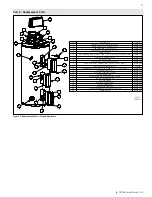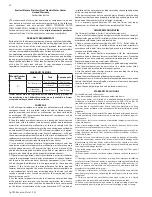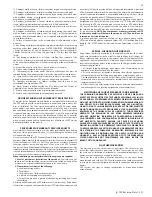
lp-790 Revision Date 1.3.22
8
To avoid water damage or scalding due to relief valve operation:
•
Discharge line must be connected to relief valve outlet and
run to a safe place of disposal. Terminate the discharge line
in a manner that will prevent possibility of severe burns or
property damage should the relief valve discharge.
•
Discharge line must be as short as possible and the same
size as the valve discharge connection throughout its
entire length.
•
Discharge line must pitch downward from the valve
and terminate at least 6” above the floor drain, making
discharge clearly visible.
•
The discharge line shall terminate plain, not threaded, with
a material serviceable for temperatures of 375
o
F or greater.
•
Do not pipe discharge to any location where freezing could
occur.
•
No valve may be installed between the relief valve and
heater or in the discharge line. Do not plug or place any
obstruction in the discharge line.
•
Test the operation of the relief valve after filling and
pressurizing the system by lifting the lever. Make sure the
valve discharges freely. If the valve fails to operate correctly,
immediately replace with a new properly rated relief valve.
•
Test T&P valve at least once annually to ensure the waterway
is clear. If valve does not operate, turn the heater “off” and
call a plumber immediately.
•
Take care whenever operating relief valve to avoid scalding
injury or property damage.
FAILURE TO COMPLY WITH THESE GUIDELINES COULD RESULT IN
FAILURE OF RELIEF VALVE OPERATION, RESULTING IN POSSIBILITY
OF SUBSTANTIAL PROPERTY DAMAGE, SEVERE PERSONAL INJURY,
OR DEATH.
RE-INSPECTION OF T&P RELIEF VALVES: T&P valves should be
inspected AT LEAST ONCE EVERY THREE YEARS, and replaced if
necessary,
by a licensed plumbing contractor or qualified service
technician to ensure that the product has not been affected by
corrosive water conditions and to ensure that the valve and
discharge line have not been altered or tampered with illegally.
Certain naturally occuring conditions may corrode the valve and
its components over time, rendering the valve inoperative. Such
conditions can only be detected if the valve and its components
are physically removed and inspected.
Do not attempt to
conduct an inspection on your own.
Contact your plumbing
contractor for a re-inspection to assure continued safety.
FAILURE TO RE-INSPECT THE T&P VALVE AS DIRECTED COULD
RESULT IN UNSAFE TEMPERATURE AND/OR PRESSURE BUILD-
UP WHICH CAN RESULT IN PROPERTY DAMAGE, SERIOUS
PERSONAL INJURY, OR DEATH.
Do not thread a cap or plug into the relief valve or block relief
valve outlet line under any circumstances! Explosion and property
damage, serious injury, or death may result.
C. Condensation
Condensation can form on the water heater when it is first filled with
water, and may also occur with a heavy water draw and very cold inlet
water temperature. This condition is not unusual and will disappear
as the water becomes heated. However, if the condensation should
continue, examine the piping and fittings for possible leaks.
Other methods of controlling thermal expansion are available.
Check
with the local water utility to determine if a check valve exists in
the cold water inlet line.
Contact your installing contractor, water
supplier, or plumbing inspector for additional information regarding
thermal expansion.
D. Insulation Blankets
If local codes require external application of insulation blanket
kits, the manufacturer’s instructions included with the kit must be
carefully followed.
In addition, pay careful attention to the following so as not to restrict
the proper function and operation of the water heater:
•
Do not cover the operating or warning labels attached to the
water heater or attempt to locate them on the exterior of the
insulation blanket.
•
Do not apply insulation to the top of the water heater. This
could interfere with the safe operation of the electrical
junction box.
•
Do not cover the jacket access panel(s) to the thermostat(s)
and heating element(s) or T&P valve.
•
Inspect the insulation blanket frequently.
Failure to follow these instructions could result in property damage,
severe personal injury, or death.
E. Temperature and Pressure Relief Valve
For protection against excessive pressures and temperatures in this
water heater, ensure temperature and pressure protective equipment
is installed as required by local codes, but not less than a combination
T&P valve meeting the requirements for
Relief Valves and Automatic
Gas Shutoff Devices for Hot Water Supply Systems, ANSI Z21.22B / CSA
4.4-M99
by a nationally recognized testing laboratory that maintains
periodic inspection of production listed equipment and materials. This
valve must be marked with a maximum set pressure not to exceed the
marked maximum working pressure of the water heater.
The water heater ships with an installed T&P valve. DO NOT OPERATE
THE WATER HEATER WITH THE T&P VALVE BLOCKED OR REMOVED! The
T&P valve must be plumbed down so discharge can exit at least 6”
above the structural floor. The relief line cannot be in contact with any
live electrical parts.





































